#Save palestine
Text
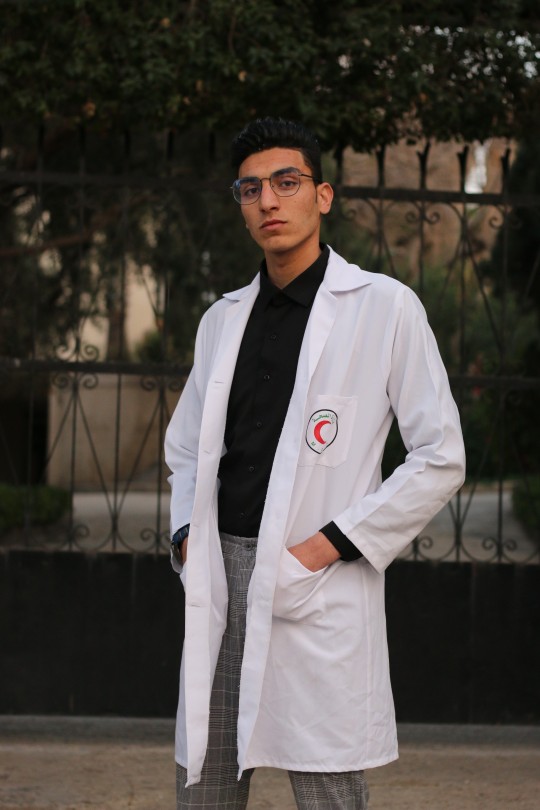
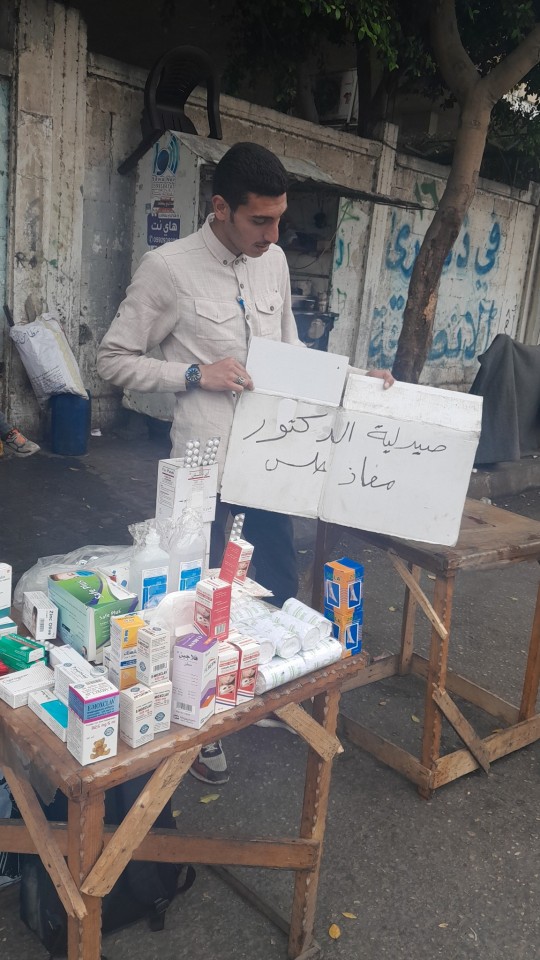
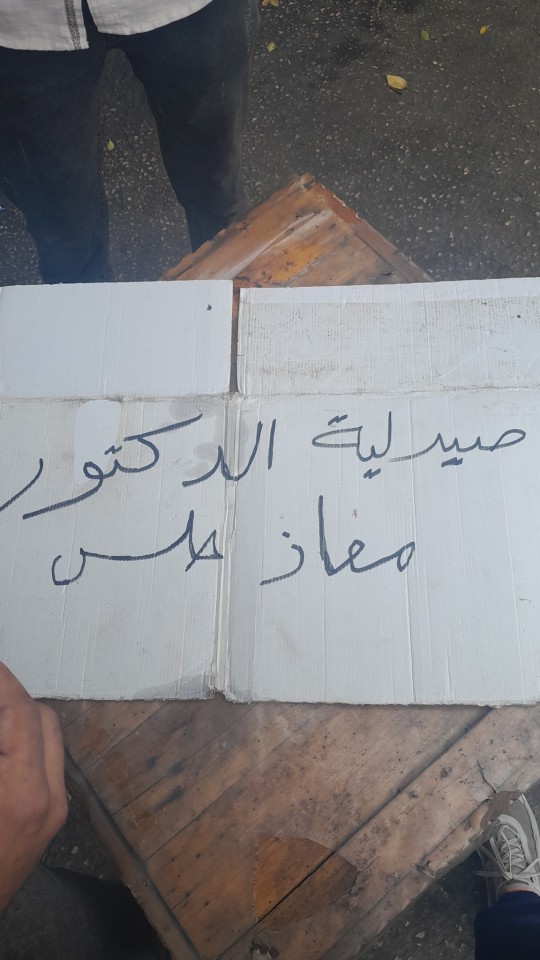
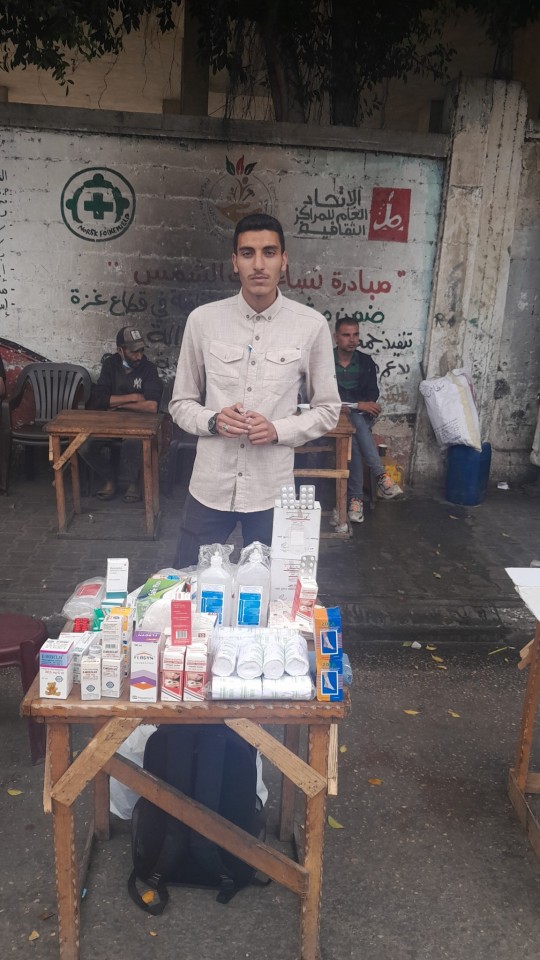
Help me, my brother Dr. Moaz Helles, and all my family to get out of Gaza
This is my brother, Doctor. Pharmacist Moaz Helles had a dream like everyone else. He works to have a family and finish his studies, but he came. The suspicious, ominous day, the day that. Demolish all. Our dreams and everyone had to practice. His profession in every. I am suffering and now it is me, my brother and all my family members. We seek to get out of this destruction and this bloodiness. Help me. My family and I. To survive Gaza, be a reason for my family’s survival. Share my donation link
1K notes
·
View notes
Text

Apparently Mike Pollock (who many of you know as Eggman in much of modern Sonic media) went batshit crazy today...fuck this earth and fuck genocide supporters



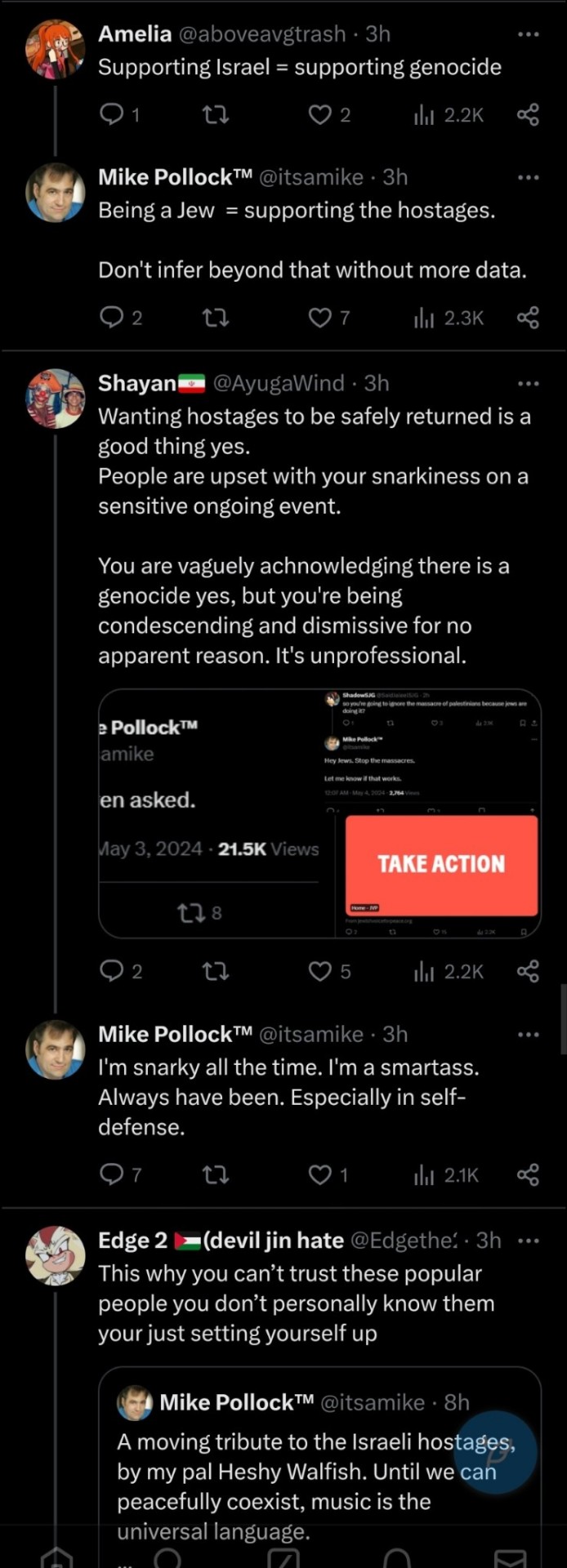
#free palestine#from the river to the sea palestine will be free#hands off rafah#ceasfire now#free gaza#mike pollock#sonic the hedgehog#fuck mike pollock#rafah#save palestine#save gaza#sonic fandom#sonic#eggman#gaza genocide
514 notes
·
View notes
Text
From a follower:
Please sign this petition to the Irish government to register the Freedom Flotilla under the Irish flag. You do not need to be an Irish citizen, but if you are, please indicate so in the relevant answer box.
The Freedom Flotilla is carrying tons of humanitarian aid for the Gaza Strip. However, the country which had registered the main ship under its flag has inexplicably revoked the registration. The Flotilla is asking for the government of Ireland to register the ship under the Irish flag so that it may legally resume its journey. More information is available at the link, but here is a brief excerpt:
We are calling on the Minister for Transport, Eamon Ryan, as a Qualified person under "The Mercantile Marine Act, 1955, as amended by the Merchant Shipping
(Miscellaneous Provisions) Act, 1998, and Sea-Fisheries and Maritime Jurisdiction Act, 2006" To Register the Freedom Flotilla ships as an Irish ships and allow it to sail to Gaza under the Irish Flag!
#gaza#gaza genocide#gaza strip#gaza under attack#free gaza#from the river to the sea palestine will be free#palestinian genocide#stop genocide#stop gaza genocide#stop the genocide#stop israel#freedom flotilla#actions#action for gaza#gaza action#help for gaza#help gaza#people helping people#save gaza#save palestine#free free palestine#free palestine#freepalastine🇵🇸#freedom for palestine#support gaza#support for palestine
380 notes
·
View notes
Text
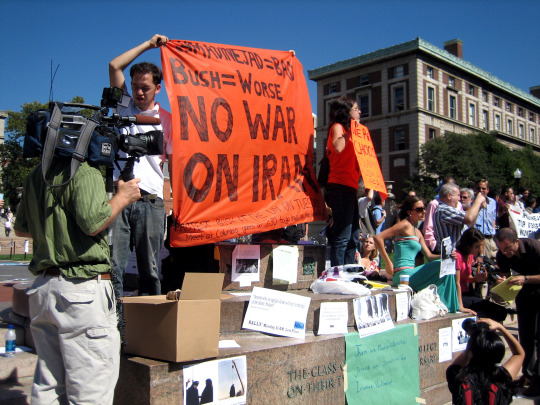
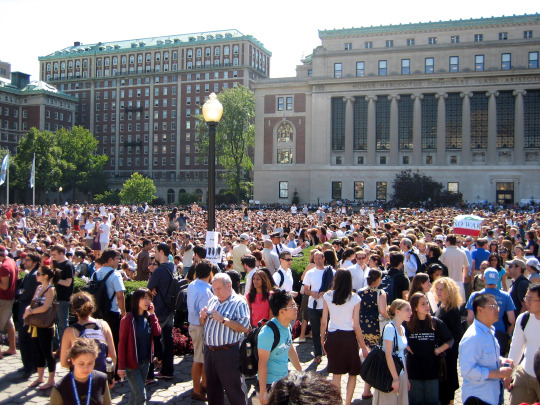
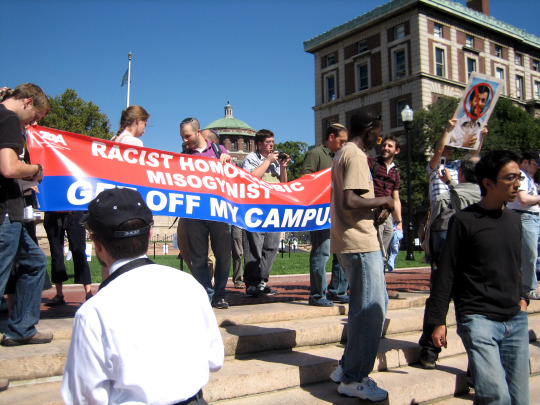
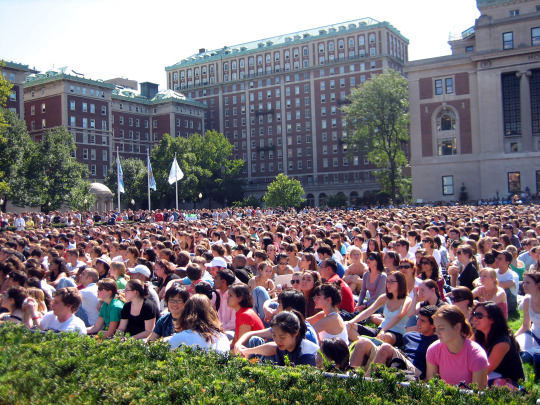


TBT to the late 00s when I was an undergrad at Columbia. It was a time when political activism and student protests saw a renaissance on campus; every year, for all 4 years I attended, there were protests—a resurgence of the spirit of '68. (I remember a meme going around comparing Ivy League schools with "How many students does it take to change a lightbulb at <insert Ivy here>?" The one for Columbia went something like "61. 1 to change the lightbulb, 30 to protest it, and 30 to counter-protest." I couldn't be more pleased, especially since the stereotypes for other Ivies were far less flattering.)
In 2007, then-President of the university Lee C. Bollinger, who was also a Free Speech scholar, invited then-President of Iran Mahmoud Ahmadinejad to speak on campus. There were protests against Ahmadinejad's arrival, and there were counter-protests, the latter calling out George W. Bush and US imperialism and upholding an anti-war message. Here are some photos I took the day of the event:
1 - Counter-protesters
3 - Protesters
4 - Students watching the event
5 - Flyers from protesters and counter-protesters
6 - Media outside the gates on Broadway
That same semester, there was a student hunger strike, calling for a reform of the Core Curriculum and expansion of the Ethnic Studies program and protesting the university's gentrification of Harlem. (I didn't take photos; this time I personally knew the protesters.) Students camped out in tents on the Lawn. And you know what? They weren't evicted. They weren't suspended. The cops weren't called. In fact, the university administration negotiated with them and agreed to meet some of their demands—the strikers won a new Major Cultures seminar requirement as part of the Core.
In 2008, on a panel commemorating the 40th anniversary of the 1968 uprising, Bollinger said, “You simply do not bring police onto a campus. All the assurances in the world cannot be kept” that police presence on campus will not result in violence.
Etc.
To the current student protestors, you are continuing Columbia tradition, and I am proud of CU students for sparking a nationwide movement. (The occupation of Hamilton Hall also harkens back to '68, when students seized control of the building to protest the Vietnam War and the proposal of a gymnasium in Morningside Park with separate entrances for students vs. the community. The spirit lives on indeed.)
To the current administration under Minouche Shafik... Sending in an armed and militarized NYPD as a response to kids peacefully protesting? How does that keep anyone safe? I can't imagine Bollinger would've been OK with how you're handling the situation. We alumni are watching.
// (c) Jenny Lam 2007
#free palestine#ceasefire now#palestine#gaza#ceasefire#from the river to the sea palestine will be free#palestine will be free#save palestine#free gaza#throwback#00s#2000s#columbia university#protest#student protests#nyc#history#activism#protests#columbia
155 notes
·
View notes
Text

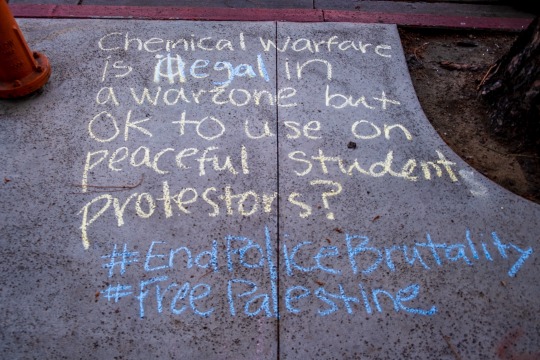
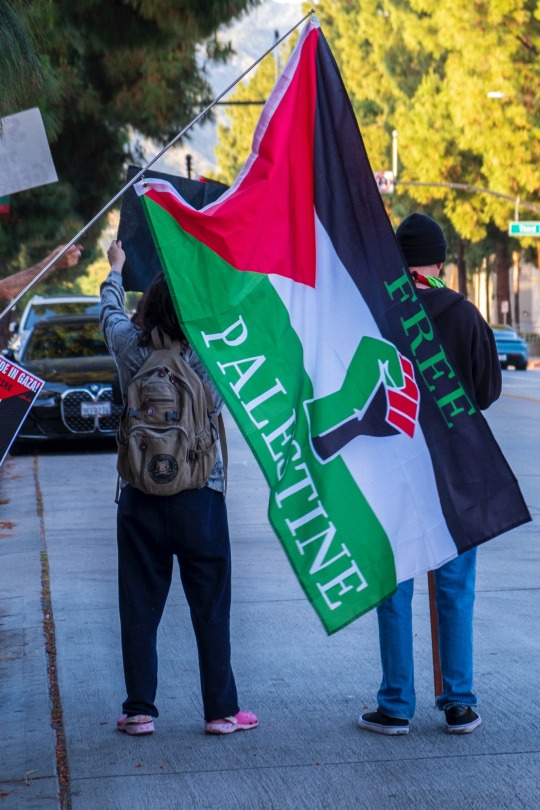
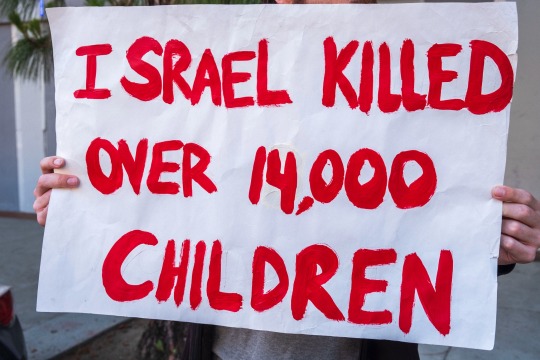

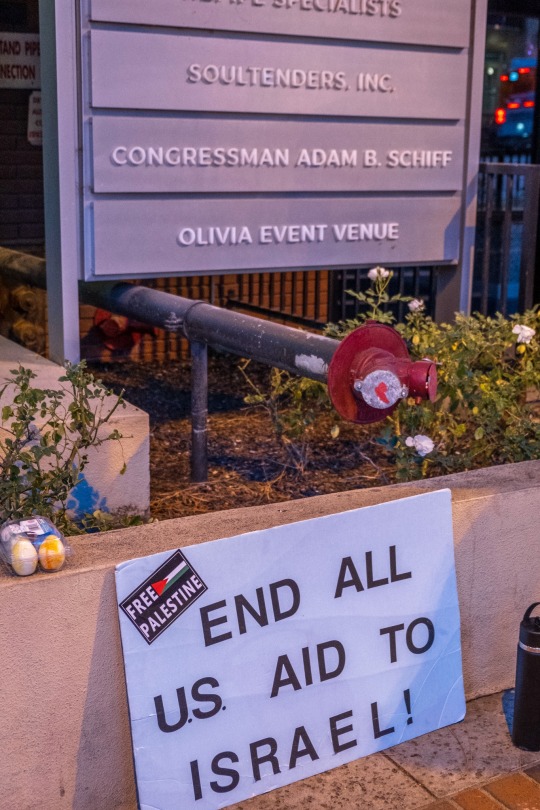

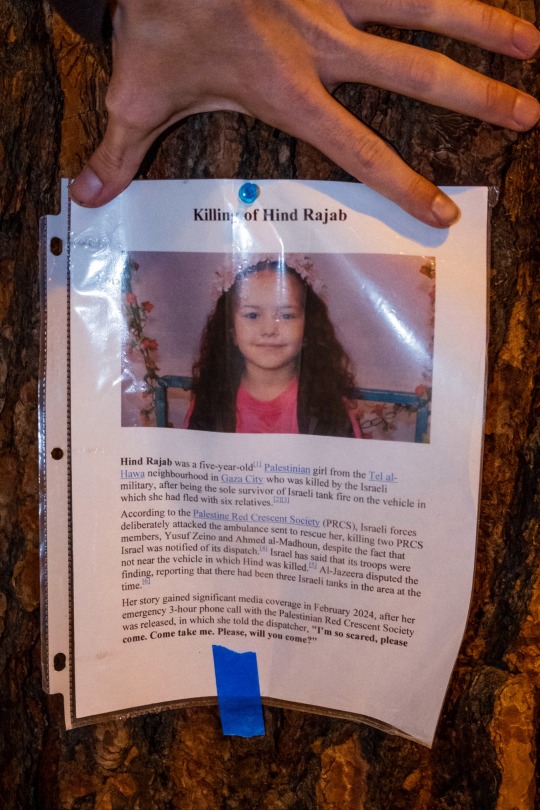
FREE FREE PALESTINE
Wednesday, May 1, 2024
Week 10 of Burbank for Palestine’s weekly protest outside Congressman Adam Schiff’s Burbank offices, including a march around downtown Burbank
You can sadly see on the sign that the thousands unit had to be whited out and increased. Horrifying
#free palestine#free gaza#from the river to the sea palestine will be free#gaza#palestine#gaza genocide#gaza strip#save palestine#stand with gaza#palestine protest#protests#i stand with palestine 🇵🇸#i stand with palestine#free palestine 🇵🇸#war on gaza#gazaunderattack#save gaza#news on gaza#freedom of speech#stop the genocide#genocide#burbank#california
166 notes
·
View notes
Text
PALESTINE UPDATES 🇵🇸
Hind’s Hall
Columbia students have taken over Hamilton Hall, and renamed it ‘Hind’s Hall.’ In honour of, Hind Rajab. A young Palestinian girl who was murdered alongside members of her family in their car by the Israeli Occupation Forces.
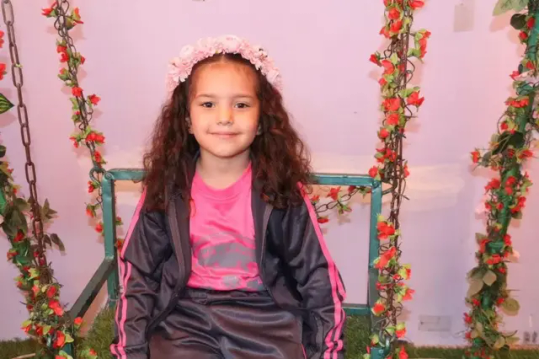
May she rest in peace, and let her story never be forgotten.
If you want to check out a snippet of the students protest I'll link the video below:
Student Protest Video
Free Palestine 🇵🇸
#free palestine#palestine#free gaza#gaza#from the river to the sea palestine will be free#israel#palestine news#gaza strip#palestine genocide#palestinian journalists#hind rajab#save palestine#human rights violations#humanitarian crisis#human rights#social justice#children of gaza#children of palestine
129 notes
·
View notes
Text

Hundreds of thousands of children, women, and elderly people are living under bombardment in Gaza, and Israel is cutting off their food supply. In addition, dozens of innocent people are being killed every day in Gaza because of Israel's brutality. Do not be complicit in their suffering, boycott all companies that support Zionist Nazism.
#syria#سورية#تمبلر بالعربي#free gaza#هنا غزة#damascus#gaza under attack#israel terrorist#تمبلريات#israel is a terrorist state#free palestinians#tel aviv#gaza strip#gaza#save palestine#save the children#save gaza#yemen#jerusalem#free palestine
64 notes
·
View notes
Text
Alternatives for Israeli products (most of them are Pakistani/Indian)
DON'T STOP BOYCOTTING !!!
DON'T STOP TALKING ABOUT PALESTINE 🇵🇸🇵🇸🇵🇸
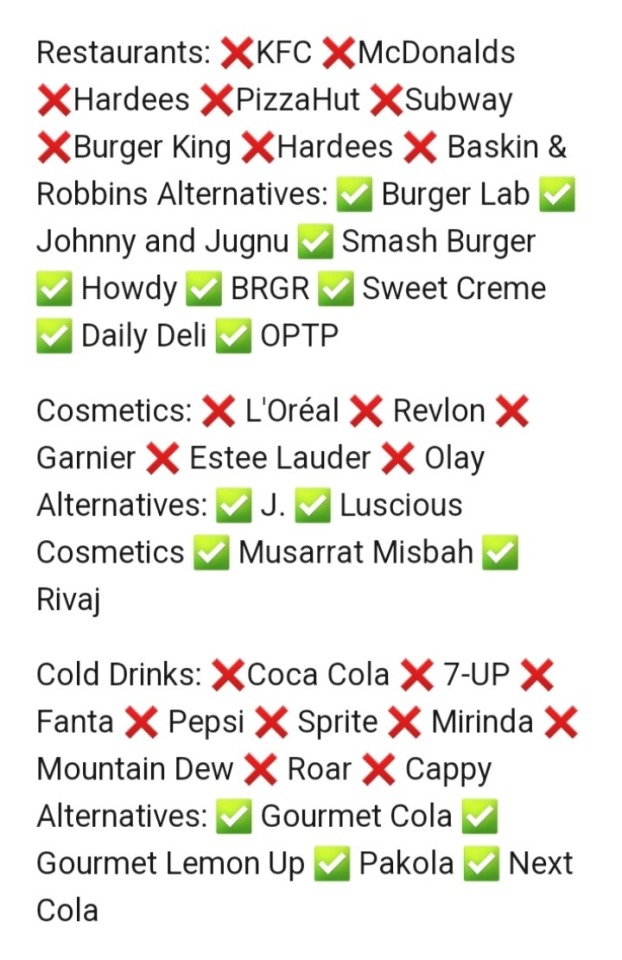
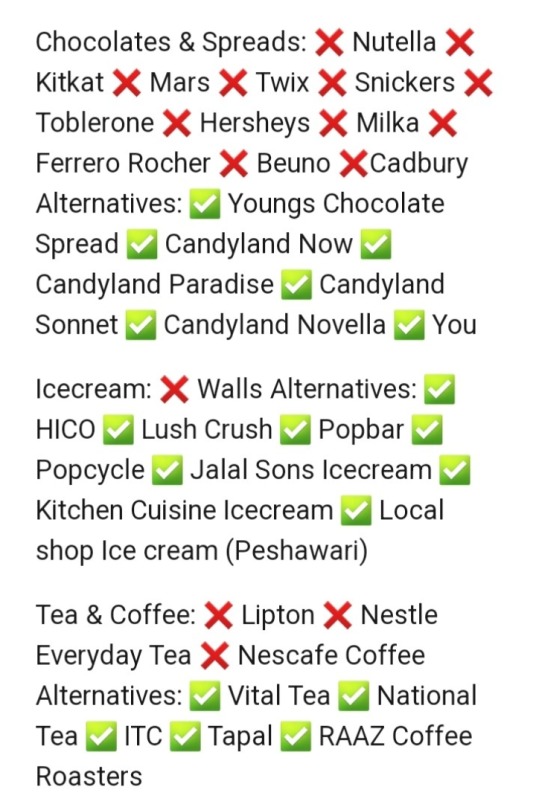


#boycott#palestine#free palestine#gaza#free gaza#fuck israel#boycotting#boycott mcdonalds#boycott starbucks#boycott israel#boycott divest sanction#bds movement#dont stop talking about palestine#pray for palestine#save palestine
57 notes
·
View notes
Text
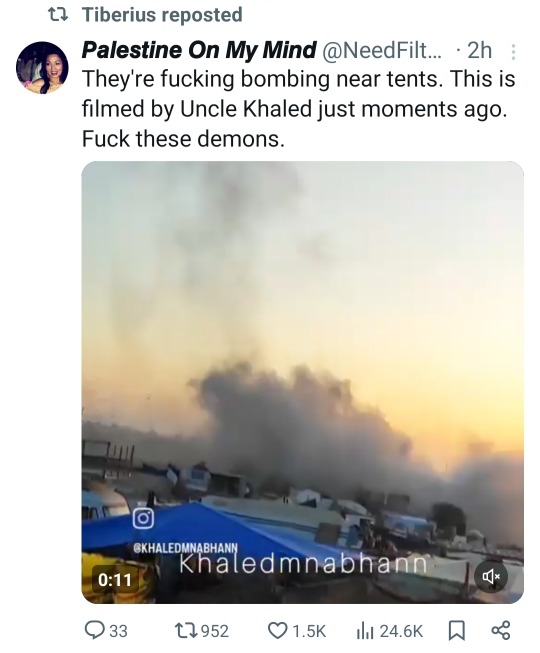
How on earth do people justify this to themselves ?
#palestine#free gaza#free palestine#gaza#israel#israel is committing genocide#israel is a war criminal#fuck israel#end israeli occupation#boycott israel#israel is a terrorist state#stop israel#from the river to the sea palestine will be free#save palestine#from the river to the sea#i stand with palestine
90 notes
·
View notes
Text
I can’t believe I have to explain to people why Palestinians deserve to live. If your conception of human rights does not extend to the majority world, there is nothing human about it at all. Just white supremacy dressed up in a suit and tie.
49 notes
·
View notes
Text
youtube
Makes one happy that some countries have the guts to cut ties with genocidal Israel while others still make excuses for them. Let’s hope that they intend to keep it that way.
#palestine#free palestine#gaza#free gaza#israel#jerusalem#israel is a terrorist state#israeli apartheid#israel is committing genocide#israel is evil#stop israel#israel is an apartheid state#israel is a war criminal#israel is an illegal occupier#israel is a genocidal state#palestine news#i stand with palestine#palestine genocide#palestine will be free#palestinian resistance#palestinians#save palestine#Youtube
25 notes
·
View notes
Text
Une vidéo dédiée à tous les étudiants du monde entier qui ne sont pas restés silencieux face au génocide à Gaza.
#palestine#campus protests#university protests#students for justice in palestine#free palestine#free free palestine#i stand with palestine#palestine genocide#genocide in palestine#palestinian genocide#palestinian resistance#palestine will be free#pro palestine#palestinians#stand with palestine#save palestine#support palestine#gaza strip#free gaza#justice for palestinians#palestinian lives matter#gaza genocide#gaza under attack#gaza under genocide#genocide in gaza#save gaza#stand with gaza#gaza#gaza free#gaza fights for freedom
24 notes
·
View notes
Text
2 May 2024
Photographer Youssef Iyad reports that the occupation bombed a group of children getting water from a well today in Zaytoun, resulting in injuries and martyrs.
WARNING: Link is graphic and upsetting
#gaza#gaza genocide#gaza strip#gaza under attack#free gaza#north gaza#from the river to the sea palestine will be free#palestinian genocide#gaza journalists#stop genocide#stop gaza genocide#stop the genocide#stop israel#gazan genocide#gaza news#zaytoun#youssef iyad#2 May 2024#gaza under bombardment#gaza update#gaza under fire#gaza under siege#gaza under genocide#save north gaza#save palestine#save gaza#end israel's genocide#israeli war crimes#israel is a terrorist state#israel is committing genocide
109 notes
·
View notes
Text
are people going to have to start lighting themselves on fire like in Vietnam? When will we finally realize something is wrong here?
#Gaza#free gaza#free palestine#yemen#gaza genocide#genocide#palestine#palestine genocide#save palestine#save gaza#save rafah#free rafah
21 notes
·
View notes
Text
‘We won’t stop’: How Columbia’s students etched a new Gaza protest legacy
Inside a movement that took over a university building and lost its encampment within 24 hours – yet refuses to die.
New York, United States — At about 10pm on Monday, April 29, I thought I would call it a night.
My student journalist colleagues and I had stayed late into the night on Columbia University’s campus the previous couple of days, reporting on a story that had grabbed the world’s attention: the pro-Palestine protests and encampment that had inspired similar campaigns in schools across the United States and globally.
As I slung my camera bag on my back and began to leave campus, walking by the camp, I got a tip from a passing protester: “I would stick around till about midnight,” they said. “Maybe go home first, though.”
Got it. I went home to charge backup camera batteries and grab spare memory cards before leaving for campus again.
Back at Columbia, it appeared that more than one of us had gotten the tip. Crowds of student journalists, all of us with matching paper badges and blue tape on our clothes, waited next to the encampment for whatever was to come. Our journalism faculty stood by our side, as they had been doing throughout.
Protesters grouped into “platoons”, and while we didn’t know what to expect, we kept eyes on different corners.
We split up to make sure different spots were covered; a few of us stuck by Pulitzer Hall, the home of Columbia Journalism School, where a small number of protesters had convened, while some others stood ready with cameras and recorders by the encampment.
That is when it all began. Campers began walking their tents off the lawn. One group began chanting. Another at the opposite end of the lawn sang protest hymns. I was with a small cohort of journalists who followed the tents to another small lawn, a clever decoy – whether intended or not – that meant many of us missed the moment, at the opposite end of campus, when protesters entered Hamilton Hall.
By the time we had run over, tens of student protesters had gathered to link arms outside the building, which their predecessors had taken over in 1968 to protest against the Vietnam War, and in 1985 to demand that Columbia divest from firms tied to apartheid South Africa.
Two of my colleagues were in the middle of the scrum, up against the doors watching two counter-protesters attempt to stop the occupation before being pushed out. Protesters rushed metal picnic tables, wooden chairs, trash cans, and planters to the doors where they were zip-tied together, effectively forming a barricade.
Two masked individuals appeared from a second-floor balcony to cheers and applause. They unfurled a hand-painted sign, “Hind’s Hall”, a reference to the six-year-old Palestinian girl who was killed with her family in their car in January as they tried to escape Israel’s military assault in Gaza.
That night, I fell asleep on the floor of a sixth-storey classroom in Pulitzer Hall to the echoes of song, one lone voice amplified through a megaphone, coming from Hamilton Hall: “This joy that I have, the world didn’t give it to me … the world can’t take it away.”
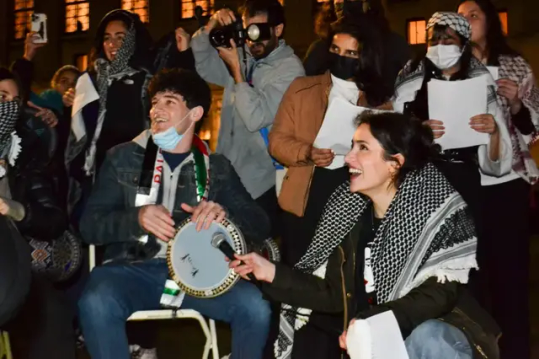
Student protesters playing music at the Columbia University encampment in New York City [Yasmeen Altaji/Al Jazeera]
The final offer
The morning before had felt very different. Columbia University’s South Lawn was packed, and the little protest village in the heart of the campus – dozens of tents and tarps comprising the “Gaza solidarity encampment” – was bustling with life, two weeks since its erection.
The protest is rooted in a decades-long movement for Palestinian rights in their homeland, and to hold Israel accountable for its illegal occupation of Palestinian territories. The current campaign against Israel’s war on Gaza – in which more than 34,000 people have been killed – also aims to pressure Columbia to divest from Israel-linked companies, just as the university did in the case of apartheid South Africa after similar protests four decades ago.
In my time covering the protest, the sounds at the encampment varied. Some days, you could hear the (Islamic) adhan, or the chants of (Jewish) Passover prayer. Or the sounds of the dumbek (drum) and sharp violins echoing microtonal hymns of Palestinian folk music and classical Andalusian muwashshah. Speakers amplified the melodies of iconic musicians like Abdel Halim Hafez and Fairuz.
Protesters shared donated hot meals – pizzas and samosas, bagels and eggs, sacks of mandarins and tubs of crackers, muffins and cookies spread on a tarp aptly called the “cornucopia”.
One camper had set up a makeshift nail parlour, painting red, white, black and green manicures matching the Palestinian flag. Cardboard “street signs” named the tight spaces between rows of tents “Walid Daqqa Road”, after the Palestinian novelist and activist who died of cancer in April, while in Israeli custody.
In the lawn’s centre, organisers routinely updated a whiteboard to reflect the day’s programmed activities: Dhuhr prayer and Shabbat dinner, with jazz in the mix, too.
In a corner of the lawn near the main campus walk, an “art guild” was buzzing with protesters painting signs, drawing patterns of the keffiyeh, decorating and personalising tent spaces.
But that Monday, campers received a final offer from the university administration under President Nemat “Minouche” Shafik: evacuate now, and evade suspension. Campers defied the order.
And by Monday night, the morning’s bustle had died down to a hum, then a whisper, before the eruption that culminated in the takeover of Hamilton Hall. At the encampment site, the zipper flap doors of empty tents billowed in the breeze. Blankets lay crumpled beside pillows still dented from a nap; a sole LED lantern left lit on the ground, a paintbrush crusted with dried red and green acrylic lay stuck on a paper plate.
It’s a community that student journalists like myself at the Columbia Journalism School had closely observed for days at a stretch, unlike the “outside media” who were only allowed on to campus in daily two-hour windows since the encampment went up. Joining us were undergraduate peers at student publications including WKCR and the Columbia Daily Spectator.
A community that, through the intensifying attention on its members, had been trying to emphasise that they weren’t the story. Signs planted across the lawn read: “All eyes on Gaza.”
But in the 24 hours that would follow, the world’s gaze on Columbia would only sharpen.
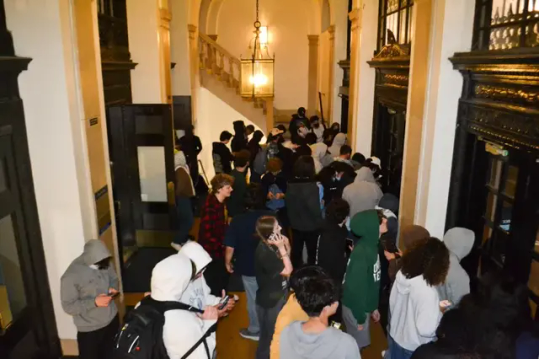
Students were trapped inside the entrance vestibule at John Jay Hall in Columbia University in New York on Tuesday, April 30, 2023 [Yasmeen Altaji/Al Jazeera]
The raid
Tuesday morning started eerily quiet. The camp was empty, save for a few protesters, and Hamilton Hall was sleepy, the only movement coming from a banner reading “INTIFADA” hanging off the side of the building.
Just a few days prior, far before the occupation of Hamilton Hall, the Columbia administration had sent a notice arguing that “to bring back the NYPD at this time would be counterproductive, further inflaming what is happening on campus, and drawing thousands to our doorstep who would threaten our community”.
The note was met with mistrust by protesters: After all, the university had already called the police to campus for the first time in more than 50 years in April to try to clear the encampment. More than 100 students had been arrested.
Instead, I heard organisers advise campers to pack their belongings in trash bags and write phone numbers on their arms in case of arrest.
By Tuesday night, their apprehension would turn into reality. The NYPD entered Columbia’s campus shortly after 9pm on Tuesday (01:00 GMT on Wednesday).
Students linked arms and sang together in anticipation before the harmonies of “We shall not be moved” merged with the march of hundreds of police officers making their way, in formation, to Hamilton Hall.
Calls through long-range acoustic devices (LRAD) to disperse or face arrest, echoed across the campus square, all the time weaving in and out of the floating tunes of the protest hymns, earworms that anyone who’d been on campus had likely come to memorise.
Protesters outside of Hamilton braced for arrest. But officers turned away from them upon arrival, and instead turned towards us – onlookers and press.
Officers instructed us to vacate the area. We walked backwards to get everything on video. “It’s easier if you face forward,” one officer said. “Turn around so you don’t fall,” another yelled repeatedly in a collective command. “Time to go inside,” another said. “Back to your dorms.”
While our backs were against the door of a building at the end of the courtyard where Hamilton was, the doors opened, and officers raised their batons, giving one final push until we were all inside. There was a moment of disorientation before we realised where we were: inside an undergraduate dormitory called John Jay Hall.
It’s where the student health centre, a dining hall, and a late-night campus eatery are. But we couldn’t see any of that. While police guarded the doors into the entry vestibule of the building in front of us, campus security guarded the rest of the building behind us, restricting access to dorm residents.
With about 30 or 40 of us squeezed into the small entry vestibule, ventilation was poor. We wouldn’t reach the bathroom. Red arrows pointed towards the emergency exit but the doors were blocked by officers. Phone batteries were dying. And most pressing, for the journalists among us: we couldn’t see Hamilton beyond the bodies of officers standing at John Jay’s glass doors.
For about three hours, students kicked at the front doors, slouched on the ground against the wall, and slept with their backpacks as pillows. One student sat cross-legged on the floor, sobbing softly while her friend comforted her.
Three hours passed in that hall before we were let out, officers directing us to dorms and buildings they did not know the names or locations of. “We know you want to get out of here. We’re doing you a favour,” one said.
As I left campus at about 1:30am, I walked past a crew hauling the tents off the South Lawn and into a garbage truck that crushed them on the spot.
[See embedded video in the article]
The remains
On Wednesday, the tension wasn’t palpable, only disappointment. The campus was quiet, but not calm. It was completely empty. No one, aside from residents and essential staff – which the journalism faculty ensured we were viewed as, as student journalists – were allowed past campus gates.
Where the encampment once stood, there were only marks of discoloured grass in the shape of rectangular tent bases.
But the movement seems anything but a ghost; on Wednesday, protesters hosted a “light show” beside the campus, projecting titles onto the public-facing side of Hamilton Hall that read “Hind’s Hall forever.”
Every year, on the eve of exams, students gather to let out what is known as a “primal scream” on campus. On Thursday, they took that tradition to Shafik’s house, shouting outside her door.
On Friday, protesters again lined the street outside of Columbia’s gate. And the words still rang through the neighbourhood: “Disclose, divest, we will not stop, we will not rest.”
#palestine#free palestine#save palestine#gaza#free gaza#save gaza#israel#israel palestine conflict#israeli apartheid#bds boycott#boycott israel#bds movement#war on gaza#gaza genocide#gaza strip#world news#current events#palestinian genocide#stop the genocide#genocide#columbia university#student activism#activism#demonstration
28 notes
·
View notes
Text
instagram
#palestine#free gaza#free palestine#current events#important#gaza#israel terrorism#israel#gaza strip#stop israel#justice for gaza#justice for palestine#justice for palestinians#eid#save gaza#help gaza#save palestine#help palestine#gaza under siege#gaza under attack#gaza under genocide#the gaza strip#gaza genocide#gazaunderattack#stop gaza genocide#wizard bisan#bisan owda#viva palestina#ramadan#ramadan is over
24 notes
·
View notes